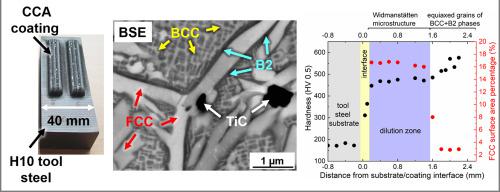Surface & Coatings Technology ( IF 5.3 ) Pub Date : 2021-04-28 , DOI: 10.1016/j.surfcoat.2021.127233 Alex Asabre , Markus B. Wilms , Aleksander Kostka , Parham Gemagami , Andreas Weisheit , Guillaume Laplanche

|
Laser metal deposition (LMD) was used to in-situ alloy a crack-free Al0.6CoCrFeNi compositionally complex alloy (CCA) with 3 at.% Ti and 0.25 at.% C additions on an initially ferritic H10 tool steel from an elemental powder blend. After LMD, the material was annealed at 900 °C for 30 min to induce martensitic hardening in the substrate. The CCA in both as-deposited and annealed states exhibited a lamellar microstructure consisting of four phases: a matrix of interwoven disordered and ordered body-centered cubic phases, titanium carbides distributed randomly within the microstructure, and disordered face-centered cubic (FCC) plates that precipitated at the grain boundaries and grew towards the center of the grains. Chemical analyses along the build-up direction of the coating revealed a compositional gradient, similar in both as-deposited and annealed states, due to the intermixing between the substrate and the CCA. Despite a strong variation of the Fe-content, the hardness and the microstructure remain roughly constant in the major part of the as-deposited coating, which contains a large fraction of FCC plates that are beneficial to increase ductility and ensure a good compatibility with the substrate. In contrast, the upper part of the as-deposited coating, corresponding to the last solidified melt pool after LMD, has a much lower FCC fraction with an enhanced hardness. After annealing, the hardness of the tool steel substrate significantly increased and the FCC volume fraction in the coating increased from ~16% (as-deposited) to ~58%. Overall the microstructure of the coating became more homogeneous while its hardness decreased only by 10–15%. These results demonstrate that the CCA can be employed as a protective coating on a less expensive tool steel to improve its lifetime during service.
中文翻译:

使用元素粉末共混物对Ti 0.6和C添加的Al 0.6 CoCrFeNi进行激光金属沉积
激光金属沉积(LMD)用于原位合金无裂纹的Al 0.6CoCrFeNi成分复杂的合金(CCA),在最初的铁素体H10工具钢中,从元素粉末混合物中添加了3%(原子)的Ti和0.25%(原子)的C。LMD之后,该材料在900°C退火30分钟,以在基材中引起马氏体硬化。处于沉积状态和退火状态的CCA均显示出由四个相组成的层状微结构:交织的无序和有序体心立方相的基质,在微结构内随机分布的碳化钛和无序面心立方(FCC)板沉淀在晶界并向晶粒中心生长。沿涂层堆积方向的化学分析显示,由于基材和CCA之间的混合,在沉积和退火状态下的成分梯度相似。尽管Fe含量变化很大,但在沉积的涂层的大部分中,硬度和微观结构仍保持大致恒定,该涂层包含大部分FCC板,有利于增加延展性并确保与FCC板的良好相容性。基质。相反,所沉积的涂层的上部对应于LMD之后的最后一个固化熔池,其FCC分数要低得多,并且硬度更高。退火后,工具钢基材的硬度显着增加,涂层中的FCC体积分数从〜16%(沉积)增加到〜58%。总的来说,涂层的微观结构变得更加均匀,而硬度仅下降了10-15%。











































 京公网安备 11010802027423号
京公网安备 11010802027423号